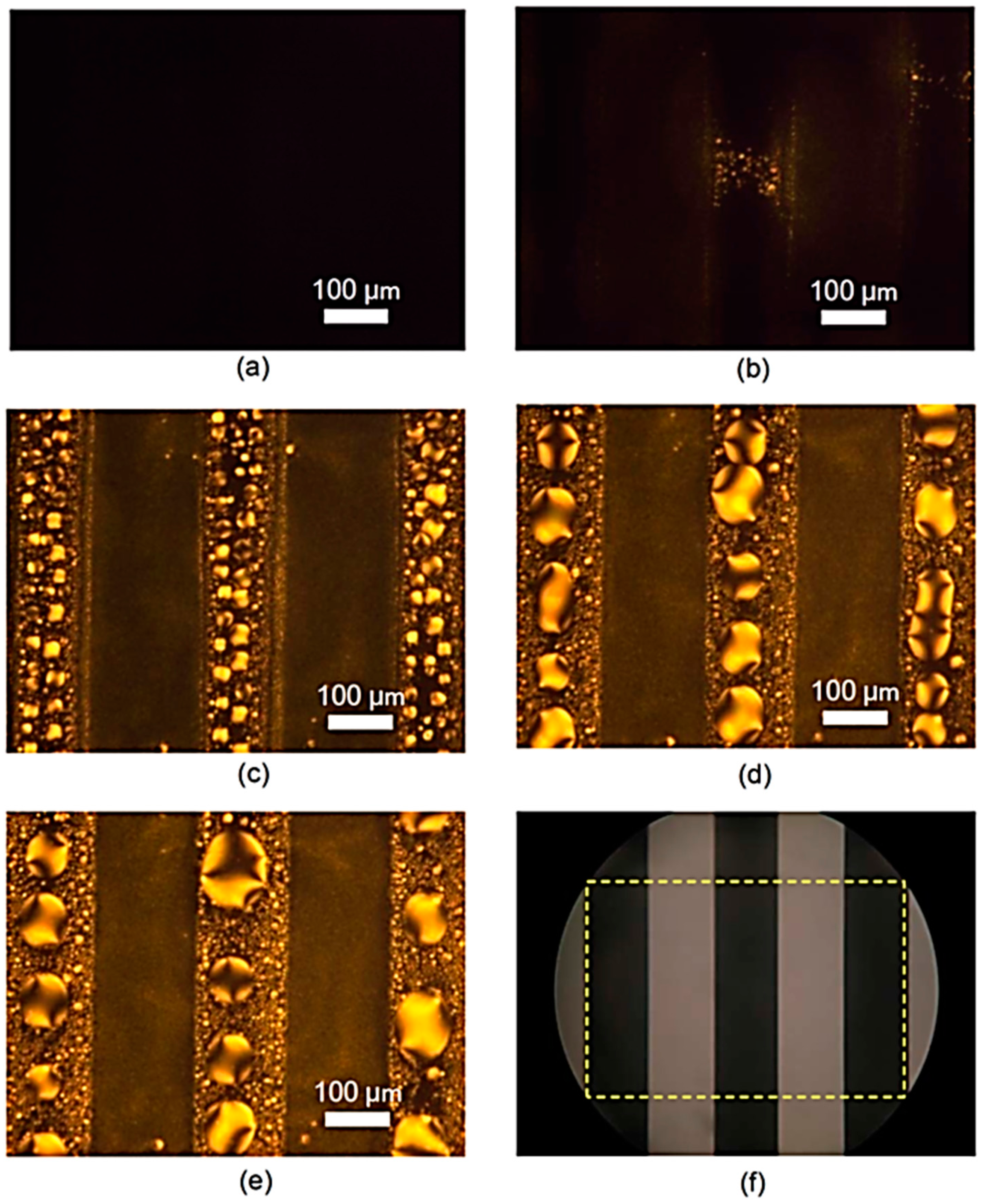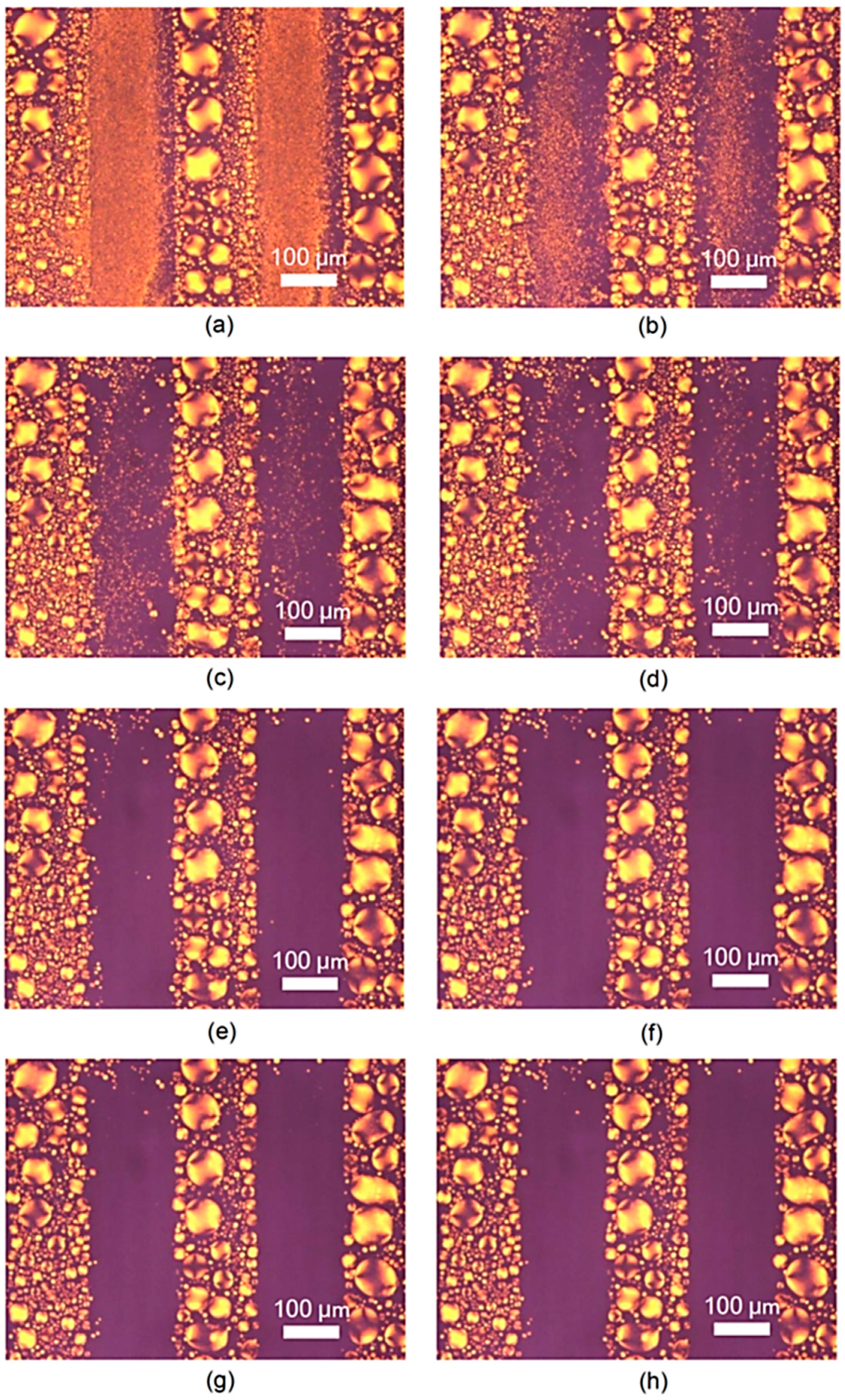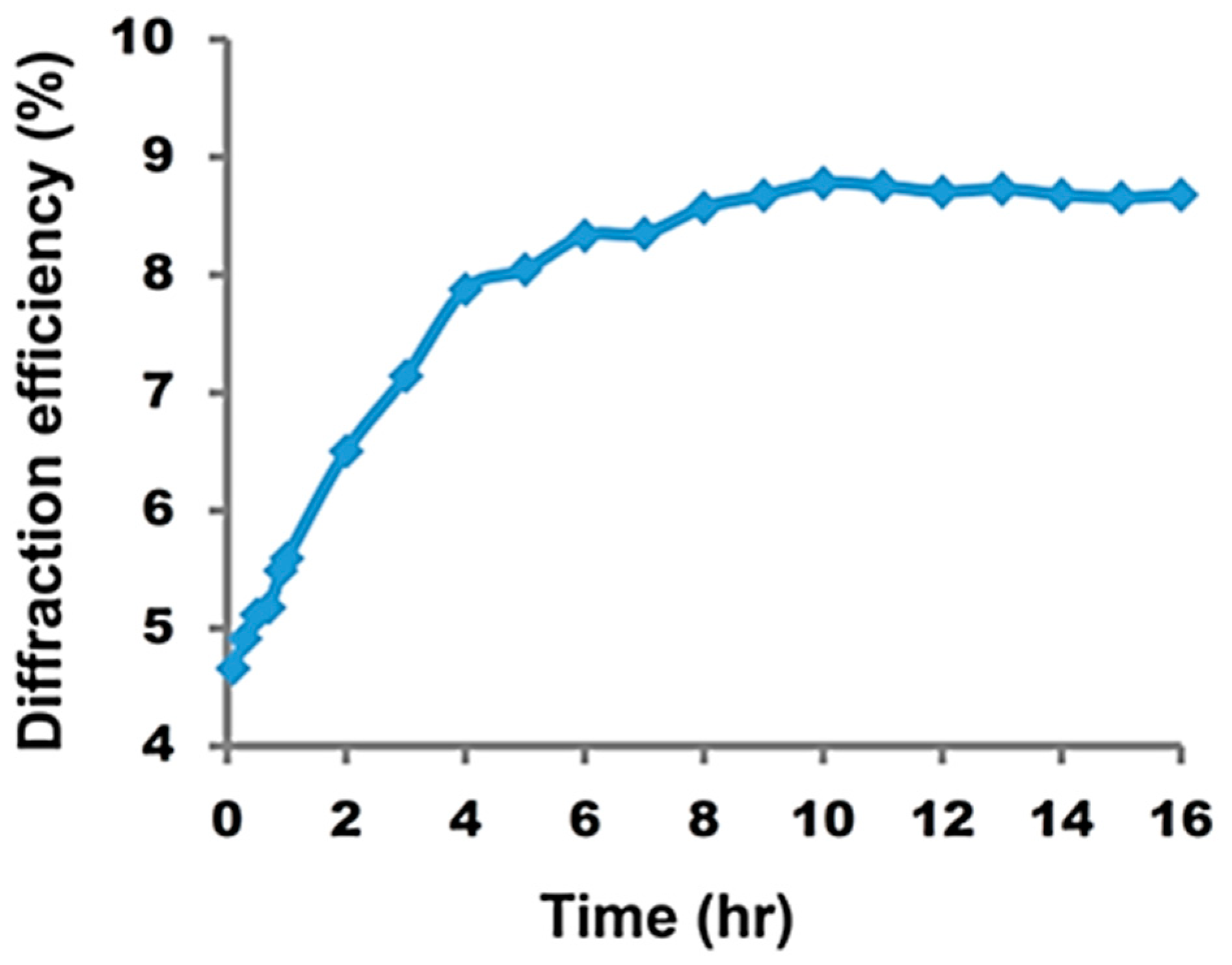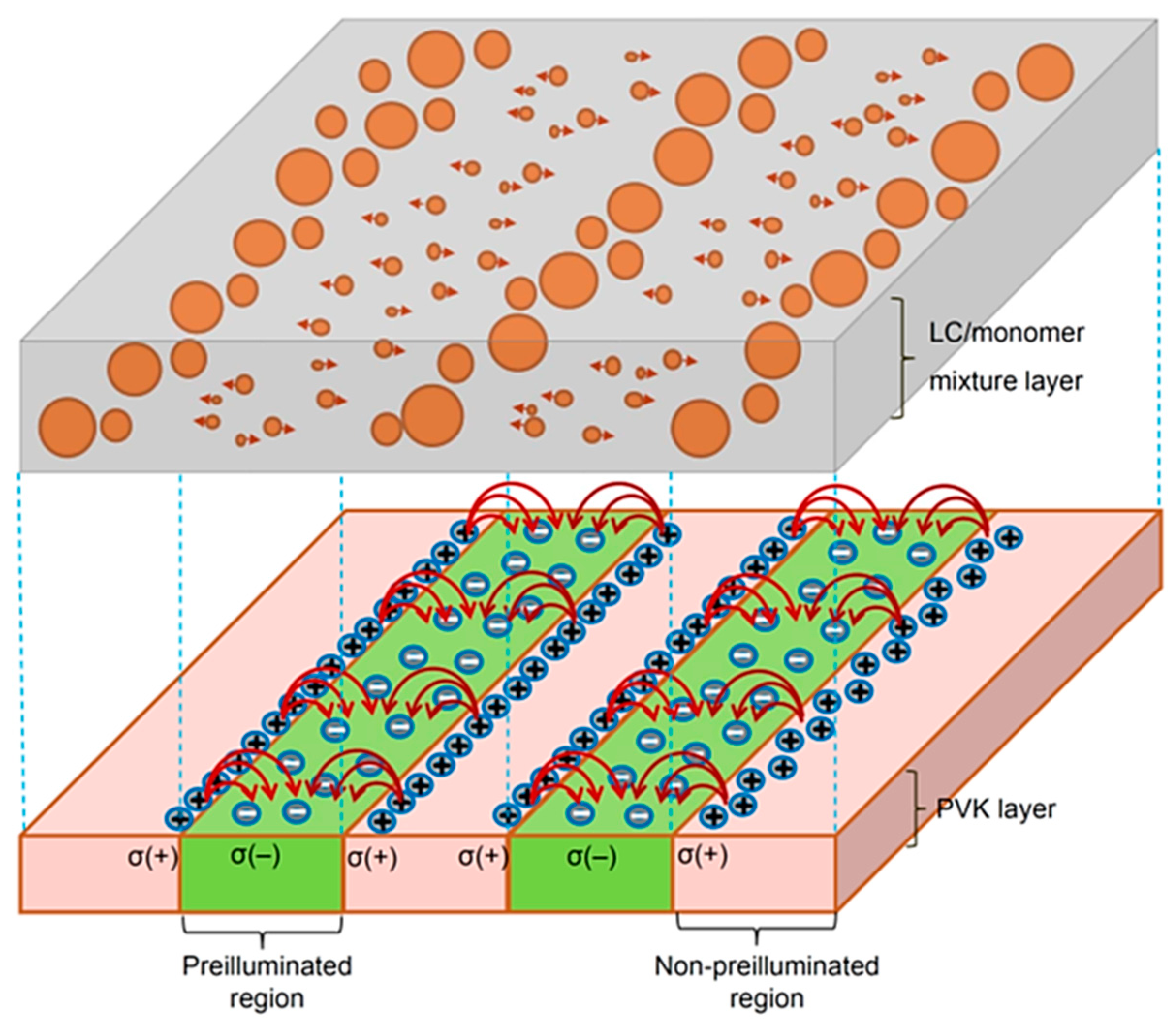External-Voltage-Free Dielectrophoresis of Liquid Crystal Droplets
Abstract
:1. Introduction
2. Sample Preparation and Experimental Setup
3. Results and Discussion
3.1. Formation of LC Droplets with Significantly Different Sizes between the Pre-Illuminated and Non-Pre-Illuminated Regions in the Grating Sample at the Cooling Step
3.2. Phenomenon of Migration of Small LC Microdroplets from the Pre-Illuminated Regions to the Non-Pre-Illuminated Regions of the Grating Sample at the Constant-TR Step
3.3. Further Discussion about the Key Role of the Discovered Non-Uniform Internal Field Playing at the Cooling Step
4. Conclusions
Supplementary Materials
Acknowledgments
Author Contributions
Conflicts of Interest
References
- Pohl, H.A. Dielectrophoresis: The Behaviorof Neutral Matter in Nonuniform Electric Fields; Cambridge University Press: Cambridge, UK, 1978; Volume 80. [Google Scholar]
- Morgan, H.; Green, N.G. AC Electrokinetics: Colloids and Nanoparticles, 2nd ed.; Research Studies Press Ltd.: Baldock, UK, 2003. [Google Scholar]
- Hughes, M.P. Nanoelectromechanics in Engineering and Biology; CRC Press: Boca Raton, FL, USA, 2002. [Google Scholar]
- Jones, T.B. Electromechanics of Particles; Cambridge University Press: New York, NY, USA, 1995. [Google Scholar]
- Kirby, B.J. Micro- and Nanoscale Fluid Mechanics: Transport in Microfluidic Devices; Cambridge University Press: New York, NY, USA, 2010. [Google Scholar]
- Pohl, H.A. The Motion and Precipitation of Suspensoids in Divergent Electric Fields. J. Appl. Phys. 1951, 22, 869–871. [Google Scholar] [CrossRef]
- Pohl, H.A. Some effects of nonuniform fields on dielectrics. J. Appl. Phys. 1958, 29, 1182–1188. [Google Scholar] [CrossRef]
- Irimajiri, A.; Hanai, T.; Inouye, A. A dielectric theory of “multi-stratified shell” model with its application to a lymphoma cell. J. Theor. Biol. 1979, 78, 251–269. [Google Scholar] [CrossRef]
- Lapizco-Encinas, B.H.; Rito-Palomares, M. Dielectrophoresis for the manipulation of nanobioparticles. Electrophoresis 2007, 28, 4521–4538. [Google Scholar] [CrossRef] [PubMed]
- Lee, S.H.; Lee, S.L.; Kim, H.Y. Electro-optic characteristics and switching principle of a nematic liquid crystal cell controlled by fringe-field switching. Appl. Phys. Lett. 1998, 73, 2881–2883. [Google Scholar] [CrossRef]
- Park, J.W.; Ahn, Y.J.; Jung, J.H.; Lee, S.H.; Lu, R.; Kim, H.Y.; Wu, S.T. Liquid crystal display using combined fringe and in-plane electric fields. Appl. Phys. Lett. 2008, 93, 081103–081105. [Google Scholar] [CrossRef]
- Wang, M.; He, L.; Zorba, S.; Yin, Y. Magnetically Actuated Liquid Crystals. Nano Lett. 2014, 14, 3966–3971. [Google Scholar] [CrossRef] [PubMed]
- Kim, Y.; Francl, J.; Taheri, B.; West, J.L. A method for the formation of polymer walls in liquid crystal/polymer mixtures. Appl. Phys. Lett. 1998, 72, 2253. [Google Scholar] [CrossRef]
- Gheorghiu, N.; West, J.L.; Glushchenko, A.V.; Mitrokhin, M. Patterned field induced polymer walls for smectic A bistable flexible displays. Appl. Phys. Lett. 2006, 88, 263511:1–263511:3. [Google Scholar] [CrossRef]
- Ren, H.; Wu, S.T.; Lin, Y.H. In situ observation of fringing-field-induced phase separation in a liquid-crystal monomer mixture. Phys. Rev. Lett. 2008, 100, 117801. [Google Scholar] [CrossRef] [PubMed]
- Penwell, R.C.; Ganguly, B.N.; Smith, T.W. Poly(N-vinylcarbazole): A selective review of its polymerization, structure, properties, and electrical characteristics. J. Polym. Sci. Macromol. Rev. 1978, 13, 63–160. [Google Scholar] [CrossRef]
- Lo, K.C.; Wang, J.D.; Lee, C.R.; Mo, T.S. Electrically controllable and polarization-independent Fresnel zone plate in a circularly symmetric hybrid-aligned liquid crystal film with a photoconductive polymer layer. Appl. Phys. Lett. 2007, 91, 181104. [Google Scholar] [CrossRef]
- Huang, C.Y.; Ma, J.M.; Mo, T.S.; Lo, K.C.; Lo, K.Y.; Lee, C.R. All-optical and polarization-independent spatial filter based on a vertically-aligned polymer-stabilized liquid crystal film with a photoconductive layer. Opt. Express 2009, 17, 22386–22392. [Google Scholar] [CrossRef] [PubMed]
- Lee, C.R.; Huang, S.C.; Lin, S.H.; Lin, Z.Y.; Huang, S.Y.; Mo, T.S. Distributed feedback laser with optoelectronic tunability in dye-doped cholesteric liquid crystal with coated photoconductive layer. Appl. Phys. B 2011, 105, 689–695. [Google Scholar] [CrossRef]
- Moerner, W.E.; Grunnet-Jepsen, A.; Thompson, C.L. Photorefractive polymers. Annu. Rev. Mater. Sci. 1997, 27, 585–623. [Google Scholar] [CrossRef]
- Wang, Y. Photoconductivity of fullerene-doped polymers. Nature 1992, 356, 585–587. [Google Scholar] [CrossRef]





© 2017 by the authors. Licensee MDPI, Basel, Switzerland. This article is an open access article distributed under the terms and conditions of the Creative Commons Attribution (CC BY) license (http://creativecommons.org/licenses/by/4.0/).
Share and Cite
Wu, S.-K.; Mo, T.-S.; Lin, J.-D.; Huang, S.-Y.; Yeh, H.-C.; Chen, L.-J.; Lee, C.-R. External-Voltage-Free Dielectrophoresis of Liquid Crystal Droplets. Crystals 2017, 7, 202. https://doi.org/10.3390/cryst7070202
Wu S-K, Mo T-S, Lin J-D, Huang S-Y, Yeh H-C, Chen L-J, Lee C-R. External-Voltage-Free Dielectrophoresis of Liquid Crystal Droplets. Crystals. 2017; 7(7):202. https://doi.org/10.3390/cryst7070202
Chicago/Turabian StyleWu, Sheng-Kuang, Ting-Shan Mo, Jia-De Lin, Shuan-Yu Huang, Hui-Chen Yeh, Lin-Jer Chen, and Chia-Rong Lee. 2017. "External-Voltage-Free Dielectrophoresis of Liquid Crystal Droplets" Crystals 7, no. 7: 202. https://doi.org/10.3390/cryst7070202





